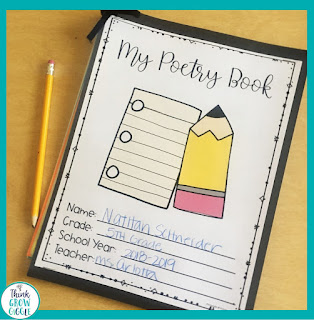Poetry
is THE most welcomed form of literature in my classroom! I love to use it to
challenge top readers and writers and to also support struggling readers and writers.
It is a great form of writing to use across the content areas, too. Don’t wait
until National Poetry Month to incorporate poetry into your upper elementary
classroom.
Try these tried and true tips and tricks to bring poetry into your classroom every day to support your students.
Try these tried and true tips and tricks to bring poetry into your classroom every day to support your students.
 I LOVE using poetry in the classroom! We read poetry each and every day. We
practice reading fluency, reading comprehension, and partner reading dialogue with each poem. By reading a poem every day, I can ensure that my students have read an
entire piece of literature and digested it through comprehension questions and
meaningful discourse. Both high and low readers enjoy reading poetry, but it is
especially engaging for reluctant and struggling readers. Click HERE to read 6
reasons why you should use poetry to engage your struggling readers and grab a
FREE poetry close reading lesson, too!
I LOVE using poetry in the classroom! We read poetry each and every day. We
practice reading fluency, reading comprehension, and partner reading dialogue with each poem. By reading a poem every day, I can ensure that my students have read an
entire piece of literature and digested it through comprehension questions and
meaningful discourse. Both high and low readers enjoy reading poetry, but it is
especially engaging for reluctant and struggling readers. Click HERE to read 6
reasons why you should use poetry to engage your struggling readers and grab a
FREE poetry close reading lesson, too! Just
as poetry can engage your most reluctant reader, it can also engage your
most reluctant writer! Poetry is loved by all children. The rhythmic flow of prose
is not only fun to read for students, but it is also seen as an attainable
writing goal for students who do not enjoy writing or are overwhelmed by the
idea of writing an entire narrative or research project. Click HERE to read
about 3 reasons why poetry is perfect to engage your struggling writers and
grab a FREE poetry writing lesson, too!
Just
as poetry can engage your most reluctant reader, it can also engage your
most reluctant writer! Poetry is loved by all children. The rhythmic flow of prose
is not only fun to read for students, but it is also seen as an attainable
writing goal for students who do not enjoy writing or are overwhelmed by the
idea of writing an entire narrative or research project. Click HERE to read
about 3 reasons why poetry is perfect to engage your struggling writers and
grab a FREE poetry writing lesson, too! Poetry
is not only highly engaging for reading and writing lessons, and it is also the
perfect form of literature to use as a read-aloud. With its short prose, you
can fit in reading aloud many poems during a long read-aloud block of time. If you are short
on time for reading aloud (which I always seem to be) you can read a few poems during
transitions or down time. Click HERE to read about my favorite 8 poetry read
aloud books that your students will love! Be sure to scoop up the FREE coordinating
activities for each one, too!
Poetry
is not only highly engaging for reading and writing lessons, and it is also the
perfect form of literature to use as a read-aloud. With its short prose, you
can fit in reading aloud many poems during a long read-aloud block of time. If you are short
on time for reading aloud (which I always seem to be) you can read a few poems during
transitions or down time. Click HERE to read about my favorite 8 poetry read
aloud books that your students will love! Be sure to scoop up the FREE coordinating
activities for each one, too!
Poetry is a great way to challenge students across the content areas and to use as a summative assessment to wrap up different reading units, too! I love using a simple acrostic poem in unique and challenging ways to increase student discourse and critical thinking, too! Click HERE to read 8 different ways you can bring acrostic poetry into your classroom to engage and challenge students of all levels.
Whether you are teaching remotely or in the classroom, this list of activities will surely engage your students AND help you save a lot of time planning! Click HERE to read how you can engage your young poets remotely or in person!
Looking for quick poetry tips that are easy to implement in your classroom? this quick read is just what you need, and bonus there is a FREE poetry guide to help you teach a variety of poetry! Click HERE to read more!
You
can also effortlessly bring poetry reading and writing into the content areas,
too! Students love to write Bio Poems about famous people in history. It makes
the perfect activity for President’s Day or during any history unit you teach. During
science, students can write a diamante or haiku poem about a broad topic or even simply a content-specific vocabulary word! It is a great way to get reluctant students writing across the
content areas.
Don’t
let poetry go untaught until National Poetry Month! Teach poetry all year long.
Your students will reap its many benefits in reading, writing, and the content
areas too!




























